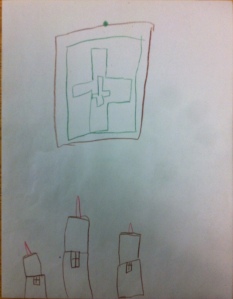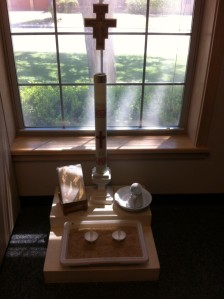How do we see into the heart of a child?
Do we watch children walk out of our atria and wonder, “Has any of my work touched their understanding, helped them understand our faith, or grown their knowledge of God?”
Of course, this very question reveals our perspective is wrong. We know as catechists that it is not we who are the teachers in our atria. Christ is the only teacher there. As set forth in the 32 Characteristics of the Catechesis of the Good Shepherd, the fruits of the child’s experience in the atrium belong to Christ; they are not ours. Our work is simply to live in faith, to be an unprofitable servant, to prepare the environment for the child, to introduce the child to a material made ready for his use, and then to observe and record her work.
Why do we observe and record the child’s work? We do so first, because this is the way we determine what material a child has mastered and which materials to present next to her in order to invite her to contemplate more fully the mysteries of faith.
However, returning to my first question, observation and documentation are also the most effective tools given us for seeing into the depths of a child’s heart.
Observation and documentation of children’s artwork over the scope of a year allowed me for instance to see into the heart of a kindergarten child, Piper, in a Level 1 atrium. Gregarious and fun-loving, Piper began her third year in a Catechesis of the Good Shepherd atrium in August, and she gravitated naturally to the center of her class’ social sphere. Upon entering the room each week, her crowd moved to the art shelf, chatting and choosing colored pencils carefully, examining them for length, sharpness, and color. Once satisfied with their tools, they settled together, still gabbing, at the long table and drew together: rainbows, flowers, cards for their mothers, and, occasionally, crosses or nativities. Using my iPhone and an app called ArtKive, I surreptitiously snapped and archived photos of their artwork. In the calm after the children left, I studied their drawings in order to answer my constant question: could I see what was going on in the hearts of the children?
Over time patterns began to emerge. In Piper’s artwork in particular her response to her true Teacher was revealed as one of longing, of joy, and of great love. A study of her drawings made over the course of the year revealed a profound interest and joy in the sacrament of baptism.
According to my observation notes for the year, it was November 11 that Piper first pinned to the prayer wall in our room a drawing she had made. To those familiar with our atrium, it was clear that her drawing represented the atrium’s baptism corner. The paschal candle, marked with a red cross, stood tall in the center of her drawing, and just as it did in our baptism area, a cross hung above it. In both her drawing and in our baptism corner, the paschal candle was flanked by two smaller candles representative of the baptismal candles given to a catechumen at his or her baptism. I found it interesting that Piper had drawn all three of the candles in her drawing with crosses and with flames. While a true baptismal candle often is marked with a cross, our small candles in the atrium are simply white vigil candles. Were these crosses based upon her own observation of baptismal candles given out at a baptism in her church? Or was she expressing a personal understanding of flaming baptismal candles as a sign of the light of the Risen Christ shared with a newly baptized individual? My observation notes for the day included these questions about her work: “Is this an exercise in artistic representation of our space, or is it theological drawing expressing her understanding and interest in baptism? Keep a watch and be prepared to speak to her parents.”
A few weeks later, on December 2, Piper left her group at the table and asked me to light the paschal candle at the baptism corner. Afterwards, as I later lit the baptismal candle for her from the Christ candle, I reminded her that when Jesus rose, he brought a risen light so strong that death could not extinguish it. I wondered with her what that light must be like and what it would be like to become filled with this light. Piper did not answer, and I did not press her. A child’s silence is often the outward sign of deep contemplation in the inner being of the child’s heart, a contemplation for which the child does not have words. So, I moved away and kept watch from a distance, leaving her to watch her small candle flame in silence. She sat there in the baptism corner watching the flame of her candle for the majority of the period before returning to the art shelf. I did not get the opportunity to see what her art expressed that day. How I wish that I had!
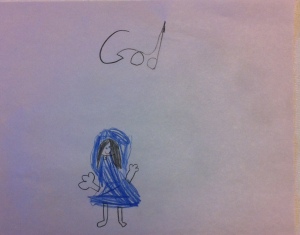 The next week the children explored the scriptures of the Annunciation from Luke. Following the discussion, Piper created a picture of a female, dressed in blue, above which she had written the word “God.” Because I was near, I heard her explain to her neighbor at the table that the figure was Mary. This did not surprise me. Mary had been a subject of interest in the presentation just before, and the Mary of our Annunciation work is a soft, blue felt. It was easy to see the iconography.
The next week the children explored the scriptures of the Annunciation from Luke. Following the discussion, Piper created a picture of a female, dressed in blue, above which she had written the word “God.” Because I was near, I heard her explain to her neighbor at the table that the figure was Mary. This did not surprise me. Mary had been a subject of interest in the presentation just before, and the Mary of our Annunciation work is a soft, blue felt. It was easy to see the iconography.
What was most interesting was Piper’s casual comment about the drawing to her neighbor: “God came into Mary from above, like when we are baptized.” The connection she made between incarnation and baptism, and her linking of the role of God the Holy Spirit overshadowing Mary at the incarnation and ourselves at baptism in a similar manner fascinated me. Truly, children have a way to see to the heart of Christian mystery in a manner which strips away the accumulations of politics and theology which divides us as adults. It took a very long time for the representatives of the various Christian denominations to the World Council of Churches conference in Lima to come to such a clarity of understanding about the shared doctrine of baptism. The Lima Document , finally adopted in 1982, states that “In God’s work of salvation, the paschal mystery of Christ’s death and resurrection is inseparably linked with the pentecostal gift of the Holy Spirit,” and it goes further to define the role of the Holy Spirit in baptism as marking a seal within the baptized which anoints the baptized as the son or daughter of God.
God bestows upon all baptized persons the anointing and the promise of the Holy Spirit, marks them with a seal and implants in their hearts the first instalment of their inheritance as sons and daughters of God. The Holy Spirit nurtures the life of faith in their hearts until the final deliverance when they will enter into its full possession, to the praise of the glory of God (II Cor. 1:21—22; Eph. 1:13-14). (Baptism, Eucharist, and Ministry. Geneva: World Council of Churches, 1982. 10. Web.)
This action of the Holy Spirit who, in descending, marks one as the inheritor, the child of God, is made manifest both in our ecumenical understanding of baptism and in the texts of incarnation which Piper was illustrating:
The angel said to her, ‘Do not be afraid, Mary, for you have found favour with God. And now, you will conceive in your womb and bear a son, and you will name him Jesus. He will be great, and will be called the Son of the Most High, and the Lord God will give to him the throne of his ancestor David. He will reign over the house of Jacob for ever, and of his kingdom there will be no end.’ Mary said to the angel, ‘How can this be, since I am a virgin? The angel said to her, ‘The Holy Spirit will come upon you, and the power of the Most High will overshadow you; therefore the child to be born will be holy; he will be called Son of God. (Luke 1:30-35)
Clearly, Piper’s drawing of the incarnation is not simply a response to the infancy narrative, but an understanding that in baptism we become as Christ, marked as an inheritor of God’s kingdom and named by God as his own child. This was a further exploration of the sacrament of baptism, a continuation of her work from the week before. Perhaps her initial drawing had not been simply a still-life of a part of our room; perhaps it had been truly a theological exploration of the articles of baptism. With this second drawing and with her statement to her classmate, Piper revealed distinctly that she was engaging in mystagogy, a meditation upon the mystery of our sacrament. I made a note in my observation folder to keep a close eye on her artwork in the weeks ahead.
On February 24 I glimpsed Piper again at work with the art materials following a presentation on the parable of the hidden treasure from Matthew 13.
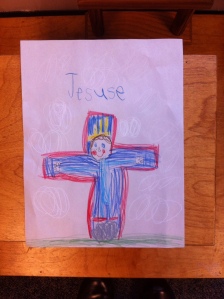 Piper first drew three yellow rectangles in ascending size on her paper; each rectangle she marked with a green/blue cross. At this point she seemed to be drawing again the baptismal candles from her very first picture. However, her next additions to the picture expanded the mystagogy of the baptismal candles. She drew a figure of a smiling man in blue, his head resting on the rectangles, and then she surrounded these elements with a red outline of a cross. Called to assist another child at the prayer table, I did not see the order in which the remaining elements were added. I heard her explain the swirls of white which surrounded the cross though. “God’s breath” she told her friend as I was passing the art table on the way to light the candles at the altar work for another child. When I walked back past, I saw that she had labeled the figure “Jesuse” and had added a gray circle at the base of the figure’s feet. I wondered about the significance of the gray circle, about God’s breath surrounding the cross, about the yellow bars above the figure’s head. I have seen similar circles in children’s drawings before. They appear frequently as the stone in images of the resurrection. Was this a moment in which Christ was caught between the cross and the tomb? Or between his death and resurrection? Why the smile? Why the bars of yellow? The ‘breath of God’ was a clue: Piper seemed to have drawn an image of the mystery of faith, (“Christ has died, Christ is risen, Christ will come again.”), a unification of the crucifixion, the tomb, the resurrection into new life. Here is a joyful Christ into whom God has breathed his ruach –again the Holy Spirit appears! — and from whom bursts forth a new and vibrant light of risen life. I couldn’t help but feel that the expression of this joyful Christ was one that invited the viewer to engage with him in this transformative, Spirit enlivened experience.
Piper first drew three yellow rectangles in ascending size on her paper; each rectangle she marked with a green/blue cross. At this point she seemed to be drawing again the baptismal candles from her very first picture. However, her next additions to the picture expanded the mystagogy of the baptismal candles. She drew a figure of a smiling man in blue, his head resting on the rectangles, and then she surrounded these elements with a red outline of a cross. Called to assist another child at the prayer table, I did not see the order in which the remaining elements were added. I heard her explain the swirls of white which surrounded the cross though. “God’s breath” she told her friend as I was passing the art table on the way to light the candles at the altar work for another child. When I walked back past, I saw that she had labeled the figure “Jesuse” and had added a gray circle at the base of the figure’s feet. I wondered about the significance of the gray circle, about God’s breath surrounding the cross, about the yellow bars above the figure’s head. I have seen similar circles in children’s drawings before. They appear frequently as the stone in images of the resurrection. Was this a moment in which Christ was caught between the cross and the tomb? Or between his death and resurrection? Why the smile? Why the bars of yellow? The ‘breath of God’ was a clue: Piper seemed to have drawn an image of the mystery of faith, (“Christ has died, Christ is risen, Christ will come again.”), a unification of the crucifixion, the tomb, the resurrection into new life. Here is a joyful Christ into whom God has breathed his ruach –again the Holy Spirit appears! — and from whom bursts forth a new and vibrant light of risen life. I couldn’t help but feel that the expression of this joyful Christ was one that invited the viewer to engage with him in this transformative, Spirit enlivened experience.
From this point on, Piper drew an avalanche of baptismal imageries. On March 3 following a presentation on the first few verses of Psalm 23 and a discussion of the verse “even though I walk through the darkest valley I am not afraid for you are with me,” Piper worked with the Eucharistic presence materials. Then sitting down to the art 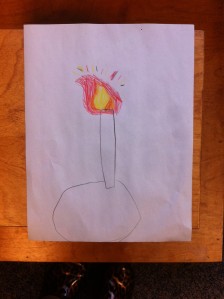 table she requested an orange pencil and went to work with great fervor and energy to depict a flame. The few lines which suggest a candle (a rudimentary rectangle and circle) appear simply place holders on the page and were added in the hurried few seconds as she cleaned up to leave the room. Unlike her earlier depictions of candles, there is not a cross or other external identifiers of the candle as a sign of Christ. Instead, her focus is purely on the flame, a symbol throughout scripture and Christian art as a sign of the Holy Spirit.
table she requested an orange pencil and went to work with great fervor and energy to depict a flame. The few lines which suggest a candle (a rudimentary rectangle and circle) appear simply place holders on the page and were added in the hurried few seconds as she cleaned up to leave the room. Unlike her earlier depictions of candles, there is not a cross or other external identifiers of the candle as a sign of Christ. Instead, her focus is purely on the flame, a symbol throughout scripture and Christian art as a sign of the Holy Spirit.
I felt confident that Piper’s intentional drawing of the flame was an expression of her experience with the Holy Spirit, and yet I was left with a question. Had she experienced the Holy Spirit in her contemplation of baptism? Piper’s flame of the Holy Spirit was clearly set in the context of a candle, and this series of drawings began with one which had as its subject the candles of the baptismal corner. Here, it was as if those small flames and as if the rectangular golden bars of her drawing of Christ’s death and resurrection had flamed into life. But is this the Paschal candle or the baptismal candle? Is this an image of Christ aglow with the Risen Light ignited by the Holy Spirit, or is it Piper filled with the light of the Risen Christ in baptism? Or is it simply God, a mystic flame, as Moses encountered him in the burning bush?
Note that the grey circle of her prior drawing of the crucifixion is still present at the foot of the candle. This gray circle seems to me to be evocative of the gray circle at the foot of Christ in her crucifixion drawing. In this case it seem to indicate that the candle IS the Risen Christ aflame with the Holy Spirit and that the rectangles of light above Christ’s head in that drawing have become in this one rays of light protruding from the head, the flame of the Light of God. But could I be sure? Could this representation of a candle truly be an image of the risen Christ illuminated by the Holy Spirit, of the light of the risen Christ given to us as a gift in baptism?
In discussion with her father about this drawing of the candle, he suggested to me at the time that this circle could simply be the cup in which the vigil candle was held. Without the context of her prior drawings and my observation of her work I would not have had support for my sense that this flame is more than a pictorial representation of an object; my sense is that this is an icon of her mystic experience with God.
On March 24, following a presentation with the class of the gesture of the washing of the hands from the Eucharist in which the words of Psalm 51 were added (“Create in me a clean heart, O God”), Piper set to work with the art materials. Once again she dew a candle with a large flame. This time though she provided additional clues for our interpretation. Above the candle she wrote “I love God!” Beside it she drew a red cross with a figure in black upon it. The candle is approximately twice the size of the cross. The connection of the cross to the candle reveals that she does synthesize the death of Christ with the light of the Risen Christ in baptism, and the size ratio of the candle to the cross reveals her understanding of the enormity of the Risen Light. Her words above the candle reveal a response of great love to this gift of Risen Light. Whereas in her drawing of the Annunciation the word “God” simply represented a descent of the Divine being, now the candle itself is all humanity – Mary, Jesus, Piper — within whom the Holy Spirit is made manifest and who anoints and nurtures a life of faith, finally setting free praise of God. Like Simeon before her, Piper is singing about the light to enlighten the nations.
Now, Piper has not read the Lima Document, created after much discussion and struggle by representatives of different Christian denominations to clarify points of doctrine in baptism are shared by all Christians. No, her clear and pure faith simply puts forth in her child’s drawing what years of adult debate concluded in that hard won consensus of faith.
Piper wasn’t finished. On April 14, following contemplation of the Holy Week narratives through use of the concrete model of the City of Jerusalem, Piper again chose the art materials. She began by drawing a great blue swath in the center of her paper, and then she sat back and looked at it. To me it looked at first as though she were beginning again to draw a Mary like that of her earlier annunciation drawing. This similarity was underscored when she wrote the name “God” above the blue swath as she had in that earlier drawing. Then she wrote “Piper” beneath it. Was this a return to the idea of the earlier picture, that just as God’s Spirit entered into Mary, God’s Spirit entered into us in baptism, I wondered?
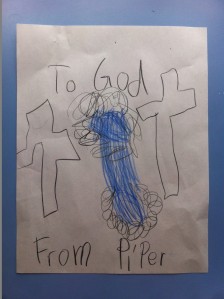 She then drew in black a cross to the left and a cross to the right. She went back to the art shelf and looked for a white pencil. Not finding one, she drew with her black pencil the looping shapes she had made on the crucifixion earlier, but this time only at the top and bottom of the blue swath. Were these also God’s breath, God’s spirit? Apparently finished with her drawing, she pinned it to the board.
She then drew in black a cross to the left and a cross to the right. She went back to the art shelf and looked for a white pencil. Not finding one, she drew with her black pencil the looping shapes she had made on the crucifixion earlier, but this time only at the top and bottom of the blue swath. Were these also God’s breath, God’s spirit? Apparently finished with her drawing, she pinned it to the board.
She wandered a bit (oh, why did I not write down to which works she wandered!) then went back, took down her drawing, and added the word “To” before “God” and “From” before Piper. With a sense of finality, she pinned the drawing to the board once more, and then went straight back to the art shelf.
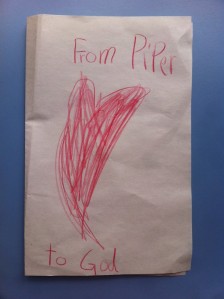 There Piper took a paper, folded it in half to make a note card, and drew a large heart on the front of it. She again wrote “To God” and “From Piper” but this time she reversed the positions of the words on the top and bottom of the page.
There Piper took a paper, folded it in half to make a note card, and drew a large heart on the front of it. She again wrote “To God” and “From Piper” but this time she reversed the positions of the words on the top and bottom of the page.
Opening the fold, she drew a large heart shaped face on the right side. Curls on the top appear to be eyes while curls on the bottom appear to be feet. She added a curve (smile?) and two lines (nostrils). A symbol of God who is love? A symbol of Piper who loves God? 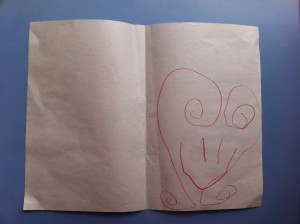 This card she brought as a gift to me (her first time ever to do this); when I asked if she wanted me to put it on the bulletin board, she just shook her head “no”, smiled, and went to put her pencils away.
This card she brought as a gift to me (her first time ever to do this); when I asked if she wanted me to put it on the bulletin board, she just shook her head “no”, smiled, and went to put her pencils away.
I’ve wondered about these last artworks. The blue swath is so similar to her first drawing of the annunciation. Is this an abstraction of humanity clothed as Mary? Or is it, with its black loops at top and bottom, an abundance of water, a waterfall? Was this water spilling from God to Piper? Was it both? And why the crosses?
The more I contemplated her work, the more I began to believe it included all of these elements. This was another expression of her growing awareness of the signs of baptism and the pouring of the consecrated water over the baptized. The outpouring of blue marked by the swirls of God’s ruach pours in abundance from the word “God” to “Piper,” and the blue is both the water and Piper/Mary experiencing the outpouring of God’s Holy Spirit. The placement of the water between the crosses captures the traditional imagery of the three crosses on Calvary, although here the waterfall takes the place of the cross of Christ. Filled with the Holy Spirit in the outpouring of the baptismal waters, Piper/Mary/Humanity is clothed as Christ. My notes for the day show that other children around her at the time she drew this image were themselves drawing images of a hill surmounted by three crosses. Piper was, unlike them, synthesizing the death of Christ, the descent of the Holy Spirit, and the Annunciation with the gestures and signs of baptism. Again, all of these meanings are present in the Lima Document’s discussion of the role of water in Baptism in which Christ’s death and resurrection, the enlightenment of the baptized by Christ, the renewal by the Holy Spirit, and the flood of cleansing water are lifted up:
The New Testament scriptures and the liturgy of the Church unfold the meaning of baptism in various images which express the riches of Christ and the gifts of his salvation. These images are some- times linked with the symbolic uses of water in the Old Testament. Baptism is participation in Christ’s death and resurrection (Rom. 6:3–5; Col. 2:12); a washing away of sin (I Cor. 6:11); a new birth (John3:5); an enlightenment by Christ (Eph. 5:14); a re- clothing in Christ (Gal. 3:27); a renewal by the Spirit(Titus 3:5); the experience of salvation from the flood(I Peter 3:20–21); an exodus from bondage (I Cor. 10:1–2) and a liberation into a new humanity in which barriers of division whether of sex or race or social status are transcended (Gal. 3:27-28; I Cor. 12:13). The images are many but the reality is one. (Baptism, Eucharist, and Ministry. Geneva: World Council of Churches, 1982. 9. Web)
So, Piper — a five year old in a preschool atrium — is meditating upon and illustrating a point of confluence of Christian doctrine from diverse denominations which was set forth by the authors of the Lima Document in this way:
In the celebration of baptism the symbolic dimension of water should be taken seriously and not minimalized. The act of immersion can vividly express the reality that in baptism the Christian participates in the death, burial and resurrection of Christ. (Baptism, Eucharist, and Ministry. Geneva: World Council of Churches, 1982. 14. Web)
And what of her final gift to me? The “love note” is, I believe, an expression again of great joy and love in response to what she realizes is the great gift of baptism, a gift from God to Piper which she has discovered in the environment she knows I have prepared for her in our school atrium. Piper, the social butterfly who chats about pink bows and kittens and birthday parties at the art table with her friends, has been contemplating and celebrating the great gifts of baptism.
Could I have missed what her heart was contemplating while she was gathered at the art shelf, the social center of the atrium? Oh, yes! If I had not kept snap shots of Piper’s artwork or notations in a journal about her work and her comments, the trail of her mystagogy would have been indecipherable. Any single drawing, seen on its own in isolation, would have hidden the greater meaning it revealed only when placed in the context of her work over many months. How many such kindlings of the Spirit in the heart of a child have I missed in the past simply because I was not observing, not documenting, the work of the child in the atrium.
To return to our initial question then, how can we see into the heart of the child, see if the environment we prepare or the presentations we offer open up the child’s heart to God’s loving presence? We cannot discern the workings of a child’s heart through our questions or our examinations. We can only perceive it if we live in the spirit of faithful observation. The unfolding plan of God is discernible only to those who wait and watch with hope.
.

